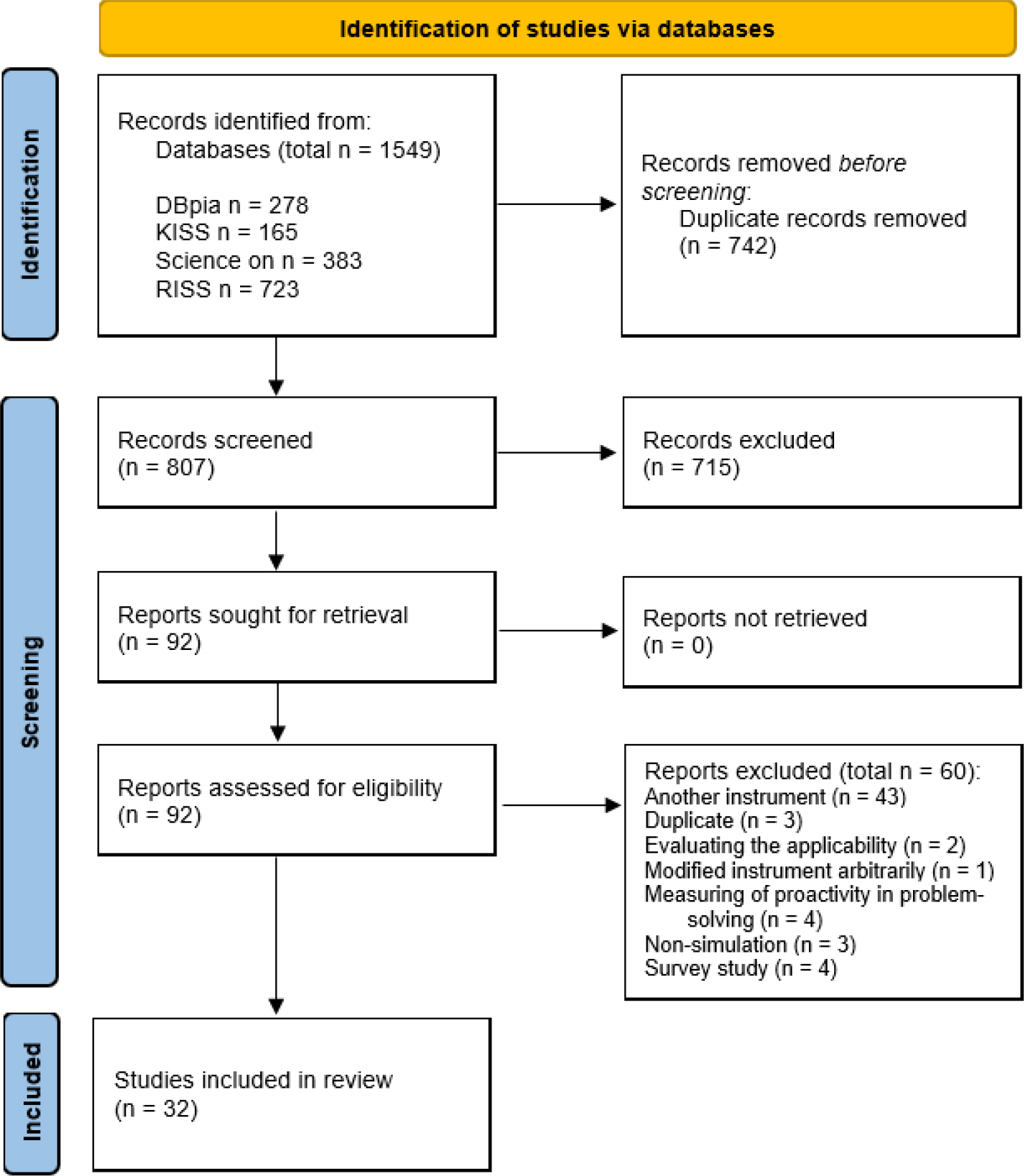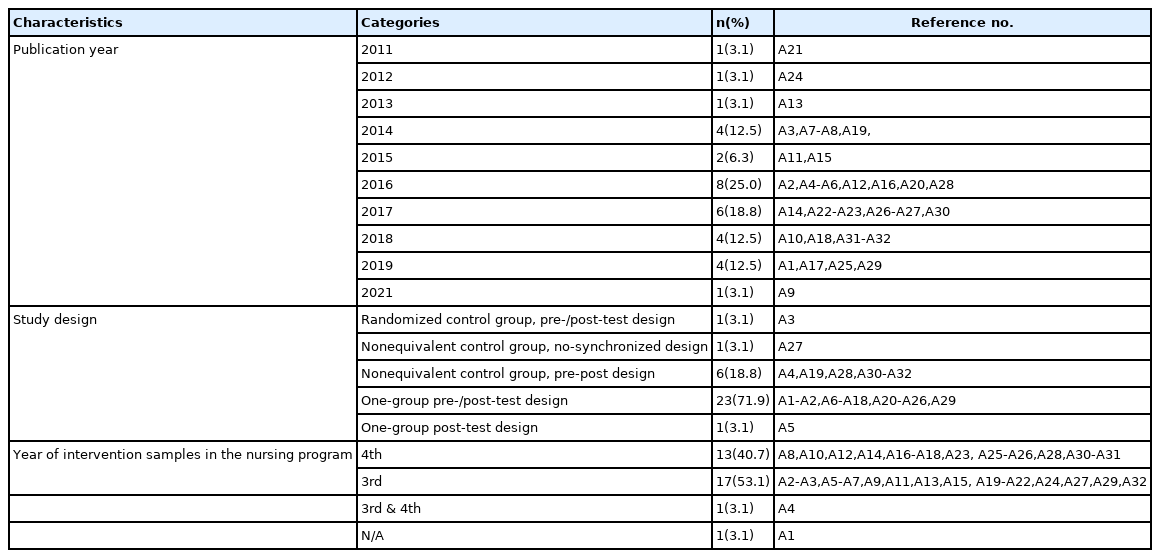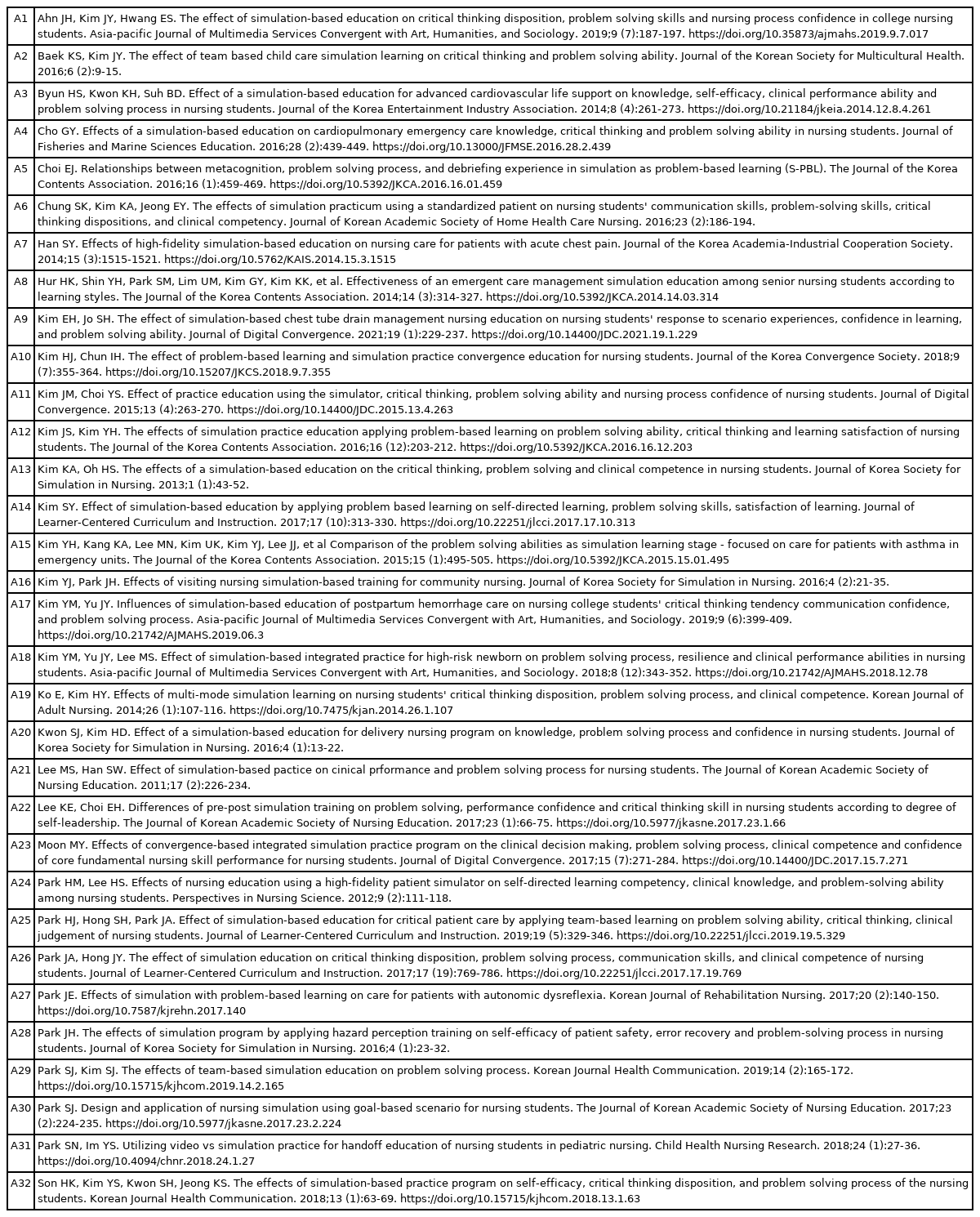국내 시뮬레이션 간호교육에 활용된 문제해결능력 측정도구 주제범위 문헌고찰: Process Behavior Survey를 중심으로
A Scoping Review of Instruments for Measuring Problem-Solving Ability in Simulation Nursing Education in Korea: A Focus on Process Behavior Survey
Article information
Trans Abstract
Purpose:
This scoping review focused on the application of simulation education for nursing college students and analyzed studies measuring problem-solving ability to present an overview of research trends and future directions.
Methods:
The scoping review followed the review guideline. The study was conducted independently by two reviewers, who searched the literature through electronic databases (DBpia, KISS, Science on, RISS, and Google Scholar).
Results:
In total, 32 studies were included in the final analysis, and each study was analyzed according to the following domains: general characteristics, simulation-related characteristics, and instrument-related characteristics. Simulation-based learning was primarily conducted for third- and fourth-year nursing students using various scenarios and high-fidelity simulators. However, the effect of simulation education on problem-solving ability was somewhat inconsistent, and some studies reported different names of tools and numbers of items by sub-area from the original instruments.
Conclusion:
It is necessary to critically reflect upon whether “Process Behavior Survey” tool can be used for simulation education. Therefore, conceptual analysis or instrument development research is needed in the future to accurately measure the problem-solving process or problem-solving ability.
서론
1 연구의 필요성
문제해결능력은 어떠한 문제에 직면했을 때, 문제를 해결하고자 하는 의지를 바탕으로 문제의 본질의 명료화, 해결방안 검토 및 수행, 그리고 그 수행 결과에 대한 평가로 반영되는 문제해결과정을 이행해 나가는 능력을 의미한다[1]. 현재의 간호현장은 복잡하고 다양하여 정확하고 빠른 판단 능력과 임상수행능력을 갖추도록 간호사에게 요구하고 있다[2]. 이러한 요구에 따라 간호학 전반에서 문제해결능력 증진을 위한 전략과 연구가 시도되고 있는데, 특히 시뮬레이션 교육 등 다양한 학습방법이 문제해결능력에 영향을 주는 것으로 보고되고 있다[2,3]. 이러한 노력과 시도는 미래 간호사를 양성하는 대학에서 간호대학생을 대상으로 더 활발히 진행되고 있다[2,4,5]. 대학의 간호교육에서 시도되고 있는 문제해결능력 학습전략은 간호대학생의 학업 흥미도, 비판적사고능력, 의사소통능력, 자기주도적 학습능력뿐 아니라 전문직태도를 함양한다고 보고되고 있다[2,3].
시뮬레이션 교육 방법은 대상자의 기본권리와 환자 안전이 강조되며 관찰 위주로 진행되는 실습을 보완하여[6], 임상 현장을 미리 경험하고 연습해 볼 수 있는 실습 교육 방법의 대안으로 활용되고 있다[4]. 특히 지식, 문제해결능력과 같은 인지적 영역과 자기효능감, 대인관계 및 의사소통, 자신감과 같은 정의적 영역, 임상수행능력에 긍정적인 효과가 있는 것으로 밝혀져[3], 다양한 시나리오를 이용하여 그 효과를 검증하는 연구가 보고되고 있다[2]. 시뮬레이션 교육에서 교수자는 실제 임상과 유사한 상황을 제공함으로써 학습 주체인 학생이 적극적이고 자발적인 사고를 하도록 유도하여 학습과정의 단계별 문제해결과정을 확인할 수 있으며, 학습자는 교수자의 즉각적인 피드백을 통해 자신의 성취 수준을 바로 확인할 수 있다는 장점이 있다[2,7,8]. 이러한 과정은 학생의 문제해결능력을 향상시키는 것으로 보고되어 이를 시뮬레이션 연구의 결과변수로 측정하고 있다[2,3,7,8].
현재 국내에서 활용되고 있는 문제해결능력 측정도구는 국내에서 개발된 것과 국외에서 개발된 것으로 구별된다. 국내 개발된 도구로 문제해결과정의 구성요소를 규명하고 측정하는데 초점을 맞춘 성인의 문제해결과정 측정도구[1]와 생애능력 측정도구의 하위영역인 문제해결능력 도구[9]가 있다. 국외에서 개발된 대표적인 측정도구인 Process Behavior Survey [10]는 국내에서 번안[11] 및 수정[12]되어 사용되고 있다. 특히 Process Behavior Survey [10] 도구는 번안과 수정과정에서 ‘문제해결과정 검사도구’[12]로 명명되어 국내 간호학 시뮬레이션 연구에서 다수 사용되고 있으나, 연구마다 ‘문제해결능력’, ‘문제해결과정’, ‘문제해결 검사도구’로 명명하여 사용되고 있으며 하위영역의 이름이나 문항 수 등이 일관되지 않게 사용되고 있다.
1978년 Lee에 의해 개발된 ‘ Process Behavior Survey’ 도구[10]는 미국 중학생의 수학 문제 훈련 효과의 검증를 위해 개발되었으며, 문제해결과정 단계의 이론적 기반으로 개발된 ‘ Study Attitudes and Methods Survey’ 도구[13]와 ‘ Hecht's Instructional Processing Activities Checklist‘[14]를 이용하여 5개 영역, 총 20문항으로 구성된 5점 Likert (0~4점) 척도를 두 개(A form and B form)의 형태로 개발되었다. Lee [10]에 따르면 문제해결은 문제해결과정(process) 평가와 그 과정을 통해 개인이 달성한 성과(performance) 평가를 통해 그 능력(skill or ability)이 확인된다고 설명하면서 문제해결과정이 개인적 특성에 영향을 받는 반면, 그 성과는 문제특성에 반응하는 학생의 특성(예, 작업시간)이 반영된다고 전제하였다. 이 도구가 국내로 들어와 문제해결과정이라고 번안되어 문제해결성과와의 연관성을 연구하는데 처음 활용되었고[11], 이후 문제해결과정 검사도구라 명명되면서 점차 알려졌으며, 문제중심학습(Problem-Based Learning, PBL)과 같은 다양한 학습 방법에 따른 문제행동과정을 평가하기 위해 수정되거나 보완되었다[12,15]. 이후 국내 간호학에서는 5단계(문제의 발견, 문제의 정의, 문제의 해결책 고안, 문제의 해결책 실행, 문제해결 검토) 25문항으로 구성된 도구를 사용하고 있다. 그러나 추상성과 주관성이 내재된 문제해결능력 혹은 문제해결과정 개념은 과학적 개념분석이나, 한국어로의 문화적 타당성 평가 없이 50여 년 동안 사용되고 있는 실정이다. 따라서 국내 간호대학생의 시뮬레이션 문제해결능력 잣대로서 ‘ Process Behavior Survey’가 일관되게 사용되었는지, 과학적 근거는 확보되었는지 그리고 현재 연구진행상황에 대한 점검이 필요한 시점이다. 본 고찰과정을 통해 향후 문제해결능력 측정도구의 이용근거를 알고, 도구사용을 위한 지식 간극을 줄이는데 기여할 수 있을 것으로 사료된다.
주제범위 문헌고찰(scoping review)은 해당분야의 이용가능한 근거의 유형을 조사하거나, 특정주제나 분야 연구가 얼마나 수행되는지, 또는 지식의 간극을 조사 분석할 목적으로 사용되며, 관심 주제에 대한 대해 광범위한 질문을 던지고 답하는데 유용하여 체계적 문헌고찰을 수행 전에 정보를 수집하고 평가하는 데 적용될 수 있는 방법이다[16]. 이에 본 연구에서는 도구의 개요나 현황을 제공할 수 있는 주제범위 문헌고찰 방법을 통해 국내 간호대학생의 시뮬레이션 교육에 활용된 ‘ Process Behavior Survey’ 도구 사용 연구를 선정하여 고찰하고자 한다.
2 연구목적
본 연구의 목적은 국내 간호대학생을 대상으로 실시된 시뮬레이션 교육 연구 중 ‘ Process Behavior Survey’ 도구를 활용한 연구를 주제범위 문헌고찰 방법으로 체계적으로 고찰하여 도구 사용과 관련된 현황을 점검하고 향후 추가적으로 필요한 연구 방향을 제안하고자 한다.
연구방법
1 연구설계
본 연구는 국내 간호대학생을 대상으로 시뮬레이션 교육에서 활용된 ‘ Process Behavior Survey’ 도구 사용 연구를 주제로 문헌을 추출하고 평가하는 주제범위 문헌고찰 연구이다.
주제범위 문헌고찰은 개별 연구결과를 합성하거나 통합추정치를 생성하는 체계적 문헌고찰과 달리 연구에서의 특정 특성과 개념을 조사하고 이를 논의하기 위해 사용되며 문헌의 비뚤림 위험 평가도 필수가 아니다[16]. 구체적인 보고지침은 PRISMA-ScR (Preferred Reporting Items for Systematic reviews and Meta-Analyses extension for Scoping Reviews)를 따른다[17].
2 연구절차
본 연구는 Seo [16]가 제시한 주제범위 문헌고찰 6단계 연구 수행 절차 중 전문가 자문을 제외한 5단계로 수행되었다(1단계 연구 질문 개발 및 도출 → 2단계 관련 연구 검색 → 3단계 문헌 선정 → 4단계 자료 기입 → 5단계 결과 분석, 요약, 보고하기). 마지막 6단계는 전문가 자문단계로 생략이 가능하며[16], 특히 본 연구에서는 개념이 명확하고 연구도구의 활용 근거와 상황을 고찰하는 주제로 시뮬레이션 교육 경험이 있는 저자로 구성되어 있어 마지막 단계는 생략하였다.
1) 1단계 연구 질문 개발 및 도출
연구 질문은 가이드라인에 따라 인구집단(population), 개념(concept), 맥락(context)로 구성하였다. 본 연구의 연구 질문은 “간호대학생 대상(population) 시뮬레이션 교육(context)에서 측정되고 있는 문제해결능력(concept) 개념의 도구인 ‘ Process Behavior Survey’가 국내 문헌에서 어떻게 활용되고 있는가?”이다.
2) 2단계 관련 연구 검색
본 연구의 자료는 간호대학생에게 시뮬레이션 교육을 적용한 문헌 중 문제해결능력을 측정한 연구논문으로, 검색 기간은 시작 시점의 제한을 두지 않고 종료 시점을 2021년 6월로 설정한 후, 두 명의 연구자가 독립적으로 Database 검색을 통해 자료를 수집하였다. 검색을 체계적이고 포괄적으로 수행하기 위해 국내 전자 데이터베이스인 DataBase Periodical Information Academic (DBpia), 한국학술정보(Koreanstudies Information Servise System, KISS), 한국과학기술정보연구원(Science on), 학술연구정보서비스(Research Information Sharing Service, RISS)를 검색하였으며, 회색 문헌 검색을 위해 Google Scholar를 검색하였다. 검색어는 ‘간호’, ‘시뮬레이션’, ‘ nurs∗’, ‘ simulation’을 주요어로 조합하여 검색하였다.
3) 3단계 문헌 선정
문헌 선정과 추출을 위해 2명의 연구자가 제목과 초록을 독립적으로 1차 선정하였으며, 2차 선정과정에서 다시 2명의 연구자가 독립적으로 선정기준과 배제 기준을 적용하여 문헌을 검토한 후 선정된 문헌의 불일치 여부를 확인하였다. 그 마지막 과정에서 불일치는 없었다.
4) 4단계 자료 기입
자료기입을 위해 추출된 문헌의 저자, 출판년도, 연구설계, 연구목적, 연구방법, 연구도구(도구명, 하위영역, 문항 수, 신뢰도 결과 등)에 대해 Microsoft excel sheet를 활용하여 기록하였다.
5) 5단계 결과 분석, 요약, 보고하기
자료 기입을 통해 추출된 자료들은 본 연구에서 개발한 분석 틀을 이용하여 연구 관련 특성, 시뮬레이션 관련 특성, 도구 관련 특성으로 분석되었다. 첫째, 연구 관련 특성으로 게재 연도, 연구 디자인과 대상자에 대한 정보를 분석했다. 둘째, 시뮬레이션 관련 특성으로 운영 교과목과 시뮬레이터, 시뮬레이션 시나리오에 대한 정보를 분석했다. 셋째, 도구 관련 특성은 도구의 하위 항목과 문항 수, 신뢰도와 측정 횟수와 간격에 해당하는 정보를 분석했다. 분석 결과는 기술통계(빈도, 백분율)를 통해 요약되었다.
3 자료선정과 배제기준
분석 자료의 선정기준은 국내에서 출간된 문헌 중 간호대학생을 대상으로 시나리오와 시뮬레이터, 표준화 환자 등을 이용하여 시뮬레이션 교육을 제공한 중재연구(유사실험, 원시실험 등) 중 Process Behavior Survey [10]를 바탕으로 Park과 Woo가 수정 ․ 보완[12]한 문제해결과정 검사지를 통해 문제해결능력을 평가한 문헌을 포함하였다.
배제기준은 시뮬레이터나 표준화 환자 등을 이용하지 않고 교육을 제공한 중재와 시나리오 없이 간호 술기만을 평가한 연구, 자가 보고식 평가도구가 아닌 개별 연구를 위해 개발된 루 브릭으로 문제해결능력을 측정한 연구와 체계적 문헌고찰과 간호학 외의 타 학문분야에서 시뮬레이션 교육 중재를 적용한 연구는 대상에서 제외하였다.
연구결과
1 대상 논문 선정
구체적인 대상 논문 선정 흐름도는 Figure 1과 같다.
자료 검색을 통해 1,549개의 문헌이 검색되었고, 중복문헌 742개를 제외한 후, 807개의 문헌의 초록을 검토하였다. 초록 검토 과정에서 선정기준에 부합하지 않는 문헌 715편을 제외한 후 남은 92편에 대하여 원문을 찾아 읽고 다시 한 번 선정기준에 부합하는지 내용을 검토하였다. 시뮬레이션을 적용하지 않은 경우 3편, 문제해결 적극성을 평가한 연구 4편, 적용 가능성 평가 2편, 조사연구 4편, 다른 도구를 사용한 연구 43편, 도구를 수정하여 사용한 연구 1편과 중복문헌 3편을 제외하고 남은 32편의 문헌이 최종 분석에 이용되었다.
2 연구관련 특성
최종 분석에 선정된 문헌은 총 32편으로, 요약된 연구 관련 특성은 Table 1과 같고, 개별 연구에 대한 구체적인 내용은 Appendix 1에 기술하였다. 분석된 문헌은 2011~2021년 사이 게재되었으며, 연구의 75.0%(24편)[A1-2,A5-18,A20-A26,A29]가 단일군, 25.0%(8편)[A3-A4,A19,A27-A28,A30-A32]가 대조군을 두고 연구를 진행하였다. 대조군을 두고 있는 연구 중 무작위 할당으로 대조군을 배정한 연구는 3.1%(1편)[A3]이었다. 또한 3학년에게 시뮬레이션 교육을 적용한 연구가 53.1%(17편)[A2-A3,A5-A7,A9,A11,A13,A15,A19-A22,A24,A27,A29, A32], 4학년 40.7%(13편)[A8,A10,A12,A14,A16-A18,A23, A25-A26,A28,A30-A31]로 보고되었으며, 실험군과 대조군을 각각 4, 3학년에게 적용한 연구가 1편[A4], 구체적으로 학년을 명시하지 않은 연구가 1편[A1]으로 보고되었다.
3 시뮬레이션 관련 특성
분석 대상 논문 중 87.6%(28편)가 시뮬레이션 운영에 있어 교과목과 연계하여 수업의 일환으로 운영되었으며, 교과목은 통합 시뮬레이션 실습이 31.3%(10편)[A4-A5,A11-A12,A14,A17-A18, A21,A23,A26]로 가장 많았고, 시뮬레이션 실습 21.9%(7편) [A6,A10,A13,A20,A29-A31], 성인간호학이 15.7%[A7,A9,A15, A22,A32], 응급간호학 9.4%[A3,A8,A19]로 나타났다. 시뮬레이션 교육 연구에 사용된 시나리오 수는 50.0%(16편)[A4,A6-A7, A9-A10,A14-A20,A22,A24,A27,A31]에서 1개라고 제시하고 있었고, 4개 이상의 시나리오를 이용하여 시뮬레이션을 운영한 연구도 21.9%[A3,A5,A8,A11,A13,A23,A26]로 나타났다. 또한 시뮬레이션 운영에 있어 고충실도 시뮬레이터를 사용한 경우가 65.6%(21편)[A1-A5,A9-A12,A14-A15,A17-A18,A20-A21,A24,A26, A28-A29,A31-A32]로 나타났고, 고충실도 시뮬레이터와 함께 표준화 환자를 적용한 경우, 저충실도 시뮬레이터와 표준화 환자를 접목한 경우가 각각 9.4%[A6,A13,A27], 3.1%[A19]로 나타났다(Table 2).
4 도구 관련 특성
최종분석에 사용된 32편의 연구 중 3편의 연구를 제외한 90.6%(29편)[A1-A7,A10-A15,A17-A32]에서 문제의 발견, 문제의 정의, 해결책 고안, 실행, 문제 해결의 검토로 5개의 하위영역을 보고하고 있었으며, 하위 항목 별 문항 수에 대하여 각기 다르게 보고하고 있었다. 도구의 하위영역별 문항 수를 보고한 20편 중 영역별 각 5문항씩으로 보고한 문헌이 43.8%(14편) [A3,A5-A6,A11-A13,A19,A21,A23,A25-A28,A31]이고, 그 외 18.7% (6편)[A17-A18,A20,A22,A29,A32]은 5영역별 문항 수를 ‘5-6- 3-5-6’, ‘5-6-3-5-5’ 또는 ‘5-6-4-5-5’로 보고했다. 도구의 신뢰도는 31편에서 Cronbach's ⍺ .83~.95로 보고했으며, 도구의 하위영역별 신뢰도까지 보고한 문헌은 2편[A27-A28]이었다. 문제해결능력을 시뮬레이션 교육 전‧후로 2회 측정한 연구가 93.8%(30편)[A1-A4,A6-A26,A28-A32], 3회 측정[A27]과 1회 측정[A5]이 각각 3.1%(1편)씩 확인되었으며, 측정 간격은 2시간에서 15주(1학기)로 분포하고 있었다. 또한 시뮬레이션 교육 제공 이후 문제해결능력이 의미 있게 변화한 연구가 65.6%(21편)[A1-A2,A6-A10,A12-A13,A15-A16,A18-A20,A22-A25,A27-A29]로 보고되었다(Table 3).
논의
본 연구는 국내에 출간된 논문 중, 간호대학생을 대상으로 시뮬레이션 교육 시 문제해결능력 혹은 문제해결과정을 측정한 연구를 바탕으로 이들 연구특성과 시뮬레이션 운영 관련 특성, 측정도구 관련 특성을 중심으로 분석하였다. 시뮬레이션 효과와 주요 변수, 시뮬레이션 운영 관련 특성을 종합하여 근거를 제시한 기존 문헌과 달리[2,3], 본 연구는 시뮬레이션 교육에서 활용한 문제해결능력 혹은 문제해결과정 측정 연구를 중심으로 이들 개념을 측정하기 위하 사용된 도구를 고찰하고 분석하였다. 이에 본 연구결과를 기반으로 향후 시뮬레이션 학습과정과 학습성과로서 문제해결능력 혹은 문제해결과정 측정도구 사용에 대한 현황을 살펴보고 향후 방향을 제시하고자 한다.
최종분석에 포함된 32개 논문은 문제해결능력 혹은 문제해결과정을 시뮬레이션 교육효과로 평가하기 위해 사용되고 있는 도구 중 ‘ Process Behavior Survey’[10]를 원 도구로 사용한 개별연구로 제한하여 선정하였다. 연구결과 32개의 시뮬레이션 교육에서 원 도구를 Park과 Woo [12]가 수정 ․ 보완한 문제해결 과정검사 도구를 활용하여 문제해결능력 혹은 문제해결과정을 측정한 것으로 나타났다. 본 도구가 사용된 시뮬레이션 교육 관련 연구들은 문제해결능력 혹은 과정을 측정하는 근거에 대하여 실제 상황에 의한 모의교육설계로 정의된 시뮬레이션 교육은, 여러 전략을 통해 문제해결 기회를 제공하므로 문제해결과정이 핵심역량이며 이를 통해 학생은 관련 지식과 임상수행능력이 향상된다고 보았다[5]. 이러한 논리는 시뮬레이션 교육 방법에서 활용한 시나리오 수와 교과목 및 시뮬레이터의 기능을 통해 확인할 수 있었다. 분석 결과, 전체 연구에서 여러 주제의 시나리오를 활용하였고, 최대 6개의 시나리오를 활용한 연구도 있었다. 통합적인 간호 상황에 따른 문제해결과정을 확인하기 위해 통합교과목에서 이러한 시뮬레이션 교육을 활용하는 연구가 가장 많았고, 32개의 연구 중 24개 연구가 고충실도(high fidelity) 시뮬레이터가 연구에 활용되었다.
그러나 모든 연구에서 시뮬레이션 교육이 문제해결능력 혹은 과정을 유의미하게 향상시키지는 못했다. 전체 32개 연구 중 21개 연구에서 통계적 유의성을 보였고 나머지는 그렇지 못했다. 간호대학생을 대상으로 한 시뮬레이션 기반 학습이 문제해결능력 증진에 상반된 결과를 보고한 원인으로 다양한 의견을 내놓으며, 추후 다양한 중재 기간과 다양한 시나리오를 적용하여 반복 연구를 수행할 필요성에 대하여 언급하였다. 일부 연구에서는 측정된 문제해결과정 단계에 대해 비판적으로 바라본 연구도 있었다. 즉 시뮬레이션 교육 효과를 평가하기 위해 사용된 주요 측정개념인 문제해결과정 혹은 문제해결능력이 PBL 학습효과평가에서는 긍정적인 효과가 있음을 일관되게 보고함[12]에도 불구하고 시뮬레이션교육 효과평가에서는 다르게 나타난 것이다.
연구결과에 영향을 주는 요소는 다양하며 측정개념이나 도구가 모든 것을 결정할 수는 없지만 사용하는 도구가 오류를 주는 주원인이 되기도 하므로[18-20] 다시 한 번 도구의 개발부터 변화과정을 점검할 필요는 있다.
서론에 언급했듯이 본 연구에서 선정한 개별연구가 측정하고 있는 도구에 대한 역사적 배경을 살펴보면, Process Behavior Survey [10]는 문제해결과정을 정의하고 이후 그 과정을 측정하기 위해 개발되었다. 국내에서는 1990년대 이후 문제해결과정이 적용되는 비구조화된 PBL에 적용되면서 Process Behavior Survey [10]가 이를 측정하는 도구로 사용되었다. 특히 Park 과 Woo [12]가 Process Behavior Survey [10]를 수정 ․ 보완해서 4단계 20문항의 문제해결 과정 검사지[11]와 5단계 28문항의 문제해결 과정검사[15] 도구를 참고하여 PBL의 목적에 맞게 5단계 25문항으로 재구성 ‘문제해결 과정검사’로 명명하였다.
Park과 Woo [12]의 연구에서 사용된 문제해결 과정검사 도구는 고등학생의 메타인지 수준에 따른 PBL에 대한 문제해결과정을 측정하기 위해 평가되었고, 사용된 이때 도구의 신뢰도 외에 도구 수정과정이나 타당성 확보를 위한 근거는 제시하지 않았다. 이 도구는 간호학 시뮬레이션 교육에서 ‘문제해결능력’으로 명명되어 측정되었고[21], 이후 연구마다 ‘문제해결과정’으로도 사용되었는데 본 연구결과, 전체 32개 연구 중 13편의 연구가 문제해결과정으로 명명하고 있었다. 원 도구와 이후 수정된 도구에서 문제해결과정으로 도입되어 사용된 도구이고 문제해결능력에 과정이 포함된 의미가 내재되어 있다하더라도[5,21], 도구의 타당화 과정 없이 고유 명칭을 변경하는 것은 지양해야 할 것으로 사료된다.
또한 고찰을 통해 도구사용이 PBL과 시뮬레이션 학습전략에 모두 활용되고 있음을 확인하였다. 그러나 시뮬레이션 교육이 PBL의 한 방법으로 설명되기도 하지만, PBL에서 제시하는 단계별 문제해결과정이 시뮬레이션 교육에 모두 적용되었다고 보기에는 한계가 있다. 즉 문제를 발견하고 정의하고 해결책을 고안하고 이를 실행한 후 다시 검토하는 것이 PBL의 문제해결과정이라면, 시뮬레이션 교육단계는 교수자의 지도하에 이루어지는 문제발견, 정의, 해결책 고안이 대부분 생략되거나 간단하게 이루어지고 학생들의 임상술기수행과 디브리핑을 통한 검토에 초점을 두는 경우가 흔하다. 실제로 본 연구에서 분석한 개별 연구에서 제시한 교육단계는 자가 학습 후 시나리오 기반 시뮬레이션을 제공하고 수행하게 한 후 디브리핑으로 설계되어 있었다. Murphy 등[22]은 PBL에서 제시한 문제발견-정의-해결책고안의 3단계를 적용한 후 시뮬레이션 교육방법을 이용해 문제해결 수행을 하도록 하고 검토하게 하는 것이 가장 좋은 학습 방법이라고 제한한 바 있으나, 이러한 단계별 노력이 제시된 연구가 본 연구 분석결과 없었다. 이러한 연구진행과정이 결국 상이한 연구결과로 이어진 것으로 조심스럽게 추정이 된다.
한편, 대부분의 연구에서는 Park과 Woo [12]가 제시한 5개 과정을 도구의 하위영역(문제의 발견, 문제의 정의, 해결책 고안, 실행, 문제 해결의 검토)으로 제시하며 각각 5문항 총 25문항으로 측정하고 있었다. 그러나 3개의 연구에서는 문제해결과정의 단계에 대한 제시가 없었으며, 6개의 연구에서는 영역별 문항 수가 Park과 Woo [12]가 제시한 영역별 문항 수와 달랐다. 그러나 이들 개별 연구에서 그 이유에 대한 근거나 변경된 문항에 대한 설명이 없었다. 도구 사용 시 원 도구와의 비교와 도구 수정내용에 대한 정보 제시의 중요성을 강조할 필요가 있다[20].
본 연구는 이상과 같이 간호대학생을 대상으로 시뮬레이션 교육에 활용된 문제해결과정 측정 연구를 선정하여 시뮬레이션 교육 현황과 도구 사용에 대해 종합하여 분석하였다. 그러나 연구에 몇 가지 제한점이 따른다. 연구설계 및 통계분석과 같은 측정도구의 속성을 보다 체계적으로 평가하기 위한 프로토콜을 사용하지 않았으며, 주제범위 문헌고찰 프로토콜을 등록하지 않고 진행되었다는 제한점이 있다. 방법론적으로 주제범위 문헌고찰을 채택함으로써 비교적 넓은 범위의 문헌을 포괄적으로 살펴볼 수 있었으나, 분석 대상을 간호대학생과 한글과 영어로 출판된 문헌으로 한정하였으며 문헌의 질평가를 수행하지 않아, 문헌의 잠재적인 비뚤림 위험을 배제할 수 없다. 또한 문제해결과정을 측정한 한 가지 도구에 집중하여 분석함에 따라 ‘문제해결능력’ 혹은 ‘문제해결과정’ 개념 및 다양한 측정도구에 대한 비교분석을 하지 못한 점은 연구의 한계이다. 따라서 개념의 해석과 일반화에는 제한이 있을 수 있어 이러한 제한점을 고려하여 본 분석 결과를 이해할 필요가 있다.
요약하면, 시뮬레이션 교육을 위한 연구설계 시 설계의 내용과 측정하고자 하는 개념 그리고 이를 측정하는 도구가 일치해야 하며, 만일 측정하고자 하는 도구가 현상을 평가하는 데 불일치 요소가 확인된다면 개념분석이나 도구의 타당화 작업이 선행되어야 한다. 아울러 문제해결과정이 과제를 수행하는 과정에서 보이는 학습자의 지식과 비판적 추론, 수행력이라면 이를 양적‧질적 병행을 통한 측정 전략이 필요할 수 있다[1,23]. 시뮬레이션 교육이 정형화된 시나리오를 이용하는 것에서 벗어나 내용과 구성이 다양해지고 있음은 시뮬레이션 교육에 있어 긍정적인 변화이므로, 임상 및 지역사회 등 간호 환경에서 발생 가능한 다양한 사례와 시나리오를 개발 및 적용하여 시뮬레이션 교육이 확장되는 시점에서, 그 효과 측정을 위한 정확한 도구 사용의 필요성을 본 연구를 통해 확인하였다.
결 론
본 연구는 국내 간호대학생 대상 시뮬레이션 교육에 활용된 문제해결과정 혹은 문제해결능력을 측정한 연구를 대상으로 연구의 일반적 특성, 시뮬레이션 및 도구 관련 특성을 살펴보고, 이와 관련된 연구 방향을 제안하기 위해 분석을 시행하였다. 분석 결과 32개의 개별 연구를 통해 시뮬레이션 교육이 3-4학년을 대상으로 고충실도 시뮬레이터와 다양한 시나리오를 사용하여 운영 중이었으며, 시나리오의 내용과 구성이 점차 구체적이고 다양해지고 있음을 확인하였다. 그러나 시뮬레이션 교육의 문제해결능력 혹은 문제해결과정에 대한 효과는 상이했다. 문제해결능력 혹은 문제해결과정 측정도구는 ‘ Process Behavior Survey’를 국내 연구자가 PBL 효과측정을 위해 수정 ․ 보완한 도구를 사용하고 있었고, 일부 연구에서 도구의 하위영역에 대한 설명이 없거나 혹은 영역별 문항 수를 다르게 보고되기도 했다. 또한 문제해결단계를 확인하기 위해 개발된 원 도구가 간호학에서 사용되면서 명칭이 수정된 것으로 파악되어 원 도구의 명칭대로 ‘문제해결과정’으로 명명할 것을 제안한다. 근본적으로는 학습단계별 문제해결과정의 행동을 측정하는 것이 목적인 도구가 시뮬레이션 교육에서도 재점검 없이 적용해도 될지에 대한 비판적 사고가 필요하다. 본 고찰을 통해 현재 사용하고 있는 도구의 개발목적과 그에 따른 사용이 일관성이 있는지 점검하였고, 시뮬레이션 교육단계에 따른 문제해결과정 혹은 문제해결능력에 대한 개념분석연구와 이에 따른 도구개발 연구를 제언하는 바이다.
Notes
CONFLICTS OF INTEREST
The authors declared no conflict of interest.
AUTHORSHIP
Study conception and design acquisition - Lim, A and Song, Y; Data collection - Lim, A and Song, Y; Data analysis & Interpre-tation - Lim, A and Song, Y; Drafting & Revision of the manuscript - Lim, A and Song, Y.






